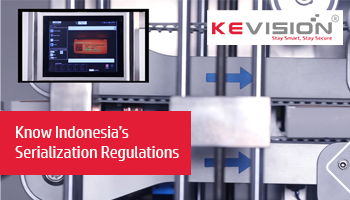
Know Indonesia’s Serialization Regulations

Indonesia, a part of the ASEAN (Association of Southeast Asian Nations) union, is one of the chartered members that took the initiative of beginning and implementing the serialization process, in 2017. Indonesian Food and Drug Authority, also abbreviated as BPOM (Bedan Pengawas obat dan Makanan) issued Regulation 33 for the year 2018 concerning the application of 2D barcodes in Drug and Food control.
They have defined two different applications of barcodes:
Identification: Identification is a method to verify the legality of drugs and food based on marketing authorization and it does not require serialization. It is aimed at the group of drugs that are included in the class of over-the-counter drugs and limited free drugs, herbal medicines, health supplements, processed foods, and cosmetics.
Authentication: Authentication is a method of tracing and verifying the legality, batch number, expiration, and serial number of medicinal and food products and requires serialization. It is aimed at the groups of hard drugs, biological products, narcotics, and psychotropic substances. Following are the details required in QR codes/ 2D barcodes respectively.
| IDENTIFICATION | AUTHENTICATION |
|---|---|
| Registration Number (MA-Marketing Authorization Number, NIE compliant product) | A marketing authorization number and/or GTIN that is valid internationally |
| Batch number/ Production code | |
| Expiry date | |
| Serialization number |
Below are the samples:
Identification (2D barcode):
Sample data encoded: NIE Number (90) – SAMPLE7110627R1

Authentication (2D barcode):
Sample Data Encoded: With GTIN: GTIN(01) + Batch(10) + EXP(17) + Serial Number(21)

Sample Data Encoded: With NIE: NIE(90) + Batch(10) + EXP(17) + Serial Number(21)

Authentication (QR code):
Sample Data Encoded: With GTIN: GTIN(01) + Batch(10) + EXP(17) + Serial Number(21)

Sample Data Encoded: With NIE: NIE(90) + Batch(10) + EXP(17) + Serial Number(21)

These codes can be issued by the manufacturers themselves or even by the BPOM. The only condition is that the codes must be readable by the BPOM track and trace application. “BPOM RI” must be printed next to the barcode that was issued by BPOM. These barcodes must be printed on the primary packaging except in the exemption situations. Contact us for exemption product list.
Pharmaceutical SCM will have to submit “2D barcode reports” to the BPOM with the help of their track and trace application.
All the pharmaceutical products should be marked with identification codes and authentication codes by 2023 and by 2025 respectively. The BPOM also made aggregation of packaging mandatory, but the details are yet to be provided.
Kevision Systems, part of the Kevin group, is a leading provider of complete solutions and services to protect your products and supplies. We are also a leading Solutions Provider for Vision-Based Inspection Systems for products, especially in the Healthcare, Food & Beverage as well as Automobile Industries. With Global Trade becoming seamless, the need for increased security & traceability of products is imperative for product authenticity. Kevision partners with clients to provide a robust & secure solution to meet product & client safety as well as regulatory compliance.